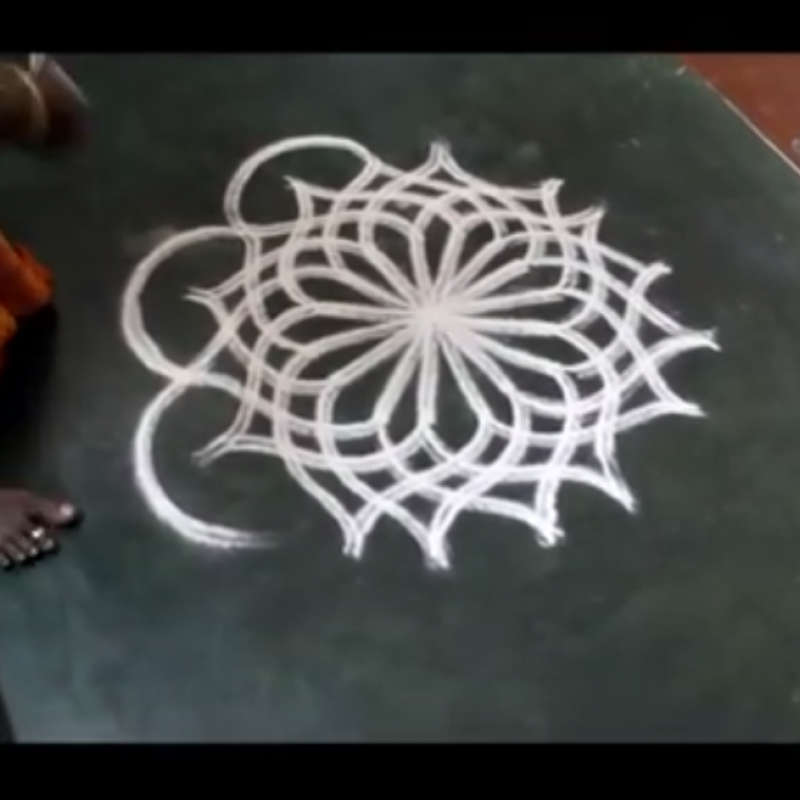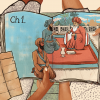The divine is invoked everywhere in India, even on the ground by drawing or painting with rice paste or vegetable and mineral-based coloured powders. In Tamil Nadu, these drawings are called kolam and bear testimony to the richness of India's graphical patrimony as well as to the extraordinary feminine creativity. Auspiciousness is not only contained within temple walls: mountains are the abode of gods, and animals and birds their vehicles. Trees, plants and flowers are not only means to worship them but also symbolise their vegetal incarnations.
Tamil Nadu, essentially rural, celebrates the sun, the cattle, and the snakes. This culture owns 'totemic' trees and addresses god in the temple as if he were a king, dressing him with great pomp, pampering and feeding him, and in the evening putting him and his queen to sleep with entertaining renditions of amorous verses. It is a society where every village offers rituals to appease the territory guardians, and a culture still deeply imbued with the worship of heroes to whom villagers of the past venerated by erecting memorial stones. It remains a region where roads with overlap the circuits of ancient temples where poets described human emotions according to the country’s five landscapes: hills, deserts, forests, the seaside, and fertile plains.
It is there in the southernmost part of the Indian peninsula that just before sunrise, women of all communities and beliefs draw on the ground. On the earth lanes of a village or on the carefully swept pavements of a city, female hands create with the tips of their fingers patterns that invite the divine to protect the house and the family. With the ground as their canvas, hands as the instrument, rice paste or rice flour and coloured powders as paint, the kolam draws the viewer into a world of divine symbols and mystical attributes. The designs vary in accordance with current events or the Hindu calendar. Their silhouettes change depending on the day, sometimes figurative, sometimes sinuous, they become linear on Tuesdays and Fridays.
It is an anonymous feminine world of powder images, which border on calligraphy, geometrical diagrams and fine embroidery. Behind every drawing, we read the story of a woman, of a mother and her daughter, and the memory of a culture through time. The kolam is a tradition passed down the generations from mother to daughter, but each household keeps a notebook where the most difficult patterns are recorded. The girls learn by watching, and later they will create new patterns with dexterity and speed.
Because the kolam blossoms at daybreak and celebrates the Earth and the link that human beings maintain with her, I always compared it with a visual chant that resonates silently in the hearts of the passers-by like the painted prayer renewed every day, not unlike the Suprabhatam, Sanskrit hymns chanted early in the morning to awaken the gods. The graphic recurrences similar to the priest’s incantations, punctuates the passing of time. By repeating motifs or lines, we try at all costs to suspend the present moment. The hand tunes the breath on the delicate weft of dust which becomes a pattern and immobilizes time.
An early hour stroll through the streets captivates the ears long before the eyes can distinguish the surrounding world. Unnoticed, objects welcome daybreak and suggest their presence by assuming a rhythmic sound form. A faint whispering of the straw brooms and the splashing of water succeed the rustles of night-insects and the croaking of crows.
In the early hours, women come out of their homes with a powder-filled container. They call out to one another and one can feel the glances which gauge the spot where they will draw. Bodies bend over at right angles; the wrist induces a slow pace to the fingers, which drop down at regular intervals, discrete rice flour or quartz powder marks called pulli in Tamil. It is on this perfectly symmetrical dotted canvas that gradually, flowers, birds, divinities, or geometrical diagrams come to life.
Other women stretch out long parallel lines in a fluid and broad movement, almost as if brushing the ground. The swaying of the arms and of the whole body, the clear and wavy gesture freezes the lines that never seem to be willing to unite with the earth. When they finally land on the floor which has become powerful by the radiance of their whiteness, they elude by their modest playfulness the malevolent forces and protect the walker as well as the house members.
To me, the diagrams seem like geometric metaphors used to illustrate the idea of time in Hinduism, a periodical cycle where creation and destruction alternates rhythm of the universe and human life. How not to be fascinated by these geometrical arabesques? They are intimately linked to a lifestyle and a culture which has always exalted the divine by drawing beauty out of disorder. The graphical exuberance akin to Tamil writing is disarming as we stroll through the streets of a city or the narrow lanes of villages at dawn.
If there is music in these lines, then it is similarly joyful and sensual. It glides under the steps of early passers-by, under the wheels of cyclists or handcarts pullers or still under those of small vans carrying away tiny grains of the rice dust as many unveiled intentions. The surrounding noise gets louder and louder as morning breaks, throbbing trucks, piercing rickshaw horns, bicycle bell ringing, sputtering mopeds, insistent calls of chai sellers, the day has begun and the busy anthill is a whirl of activity.
Today, the cultural as well as the economic context for the kolam has changed in Tamil Nadu. Women are working so the house is no more the only place for this morning ritual. Competitions take place in schools, in public halls or on the street like the Mylapore contest in Chennai. Welfare schemes use it as a tool to focus on social harmony and to promote awareness of environmental and health issues. Overseas, among expatriate Indian diasporas, kolam explores new areas, reshaping itself according to new socio-cultural backgrounds.
The journey from a world to another world, from one culture to another has surely expanded its significance but hopefully the essential will remain through its intrinsic values, which are to welcome, to embellish, to pay tribute, to celebrate, and to attract prosperity.
(Read more on the author's website on Kolam, Kalam, South Indian ephemeral ground paintings)
Videos by Chantal Jumel












